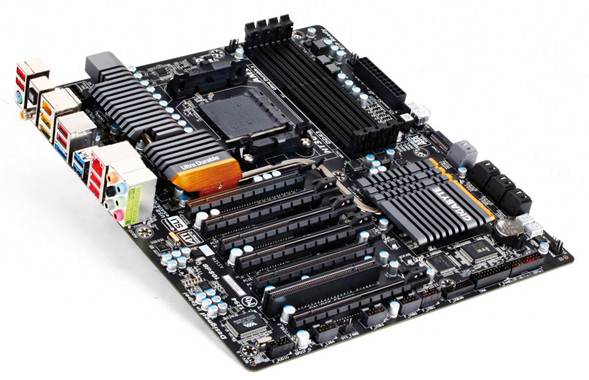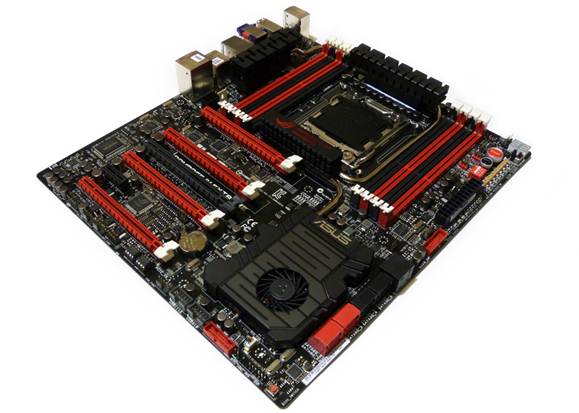High-performance AMD motherboards tend to
top out slightly lower than their Intel counterparts, purely because the CPUs
do just that, but that's not to say that AMD boards are off the table for
high-performance computing. Indeed, their relative modesty means it's
substantially cheaper to buy a top-of-the-range AMD motherboard for gaming and
overclocking, safe in the knowledge that you're being sold the best in the
line. The GA-990FXA-UD7 is Gigabyte's first foray into Bulldozer-based gaming
motherboards, and a close relative of the GA-990FXA-UD3 seen earlier.
Although it has many of the same features
as its younger sibling, the main difference is that the GA-990FXA-UD7 supports
four-way SLI and CrossFireX, as opposed to the dual-card support that the UD3
offers. That alone should tell you that the UD7 is aimed at gamers eager to get
the most fluid, high-resolution graphics out of their machines, and indeed,
that is what it delivers under such a setup.
There are six SATA 6Gbps ports available,
an amount equal to both the UD3 model and Asus' equivalent motherboard, the
Sabretooth 990FX. Again, you get six PCIe slots and a PCI slot, with four USB
3.0 ports in addition to the board's fourteen USB 2.0 ports, three of which
support the power-boost device charge mode. A standard four memory banks might
seem like a disappointing oversight when compared to the Rampage IV's eight,
but it's still a reasonable number, even for gamers. Form-wise, it's a little
larger than a standard ATX, but shouldn't require much additional space.

Gigabyte
GA-990FXA-UD7
In terms of performance, there are a few
weak areas. In particular, benchmarks show that the USB 3.0 ports perform a
little more slowly than those on similar models from rival manufacturers, but
the UD7 claws back some credibility by overclocking comfortably beyond its
normal range. Coupled with water-cooling, you could end up with a seriously
more powerful system than you've paid for at no extra cost. If you're willing
to take the risk, there are potentially great rewards to be reaped, and that's
what makes this a board for serious gamers.
$240-$320 (Intel): Gigabyte GA-Z77X-UD5H-WB
If you're in the market for an Ivy Bridge
motherboard. Gigabyte's GA-Z77X-UD5H-WB model is one of the most feature-rich,
and that makes it a great choice for those with the cash to spend.
Qualities you can expect to see include USB
3.0 support, SATA 6Gbps, support for up to three monitors on integrated
graphics alone, SLI and CrossFireX support, PCI Express 3.0 support, and (for
the WB model only) a boxed-in expansion card with dual Wi-Fi antennae and a
Bluetooth 4.0-ready adaptor. Throw a stone and you'll hit something impressive.

Gigabyte
GA-Z77X-UD5H-WB
That said, of its many impressive features,
perhaps the most interesting is the LucidLogix Universal MVP software. This
allows you to instantly switch between your on-board GPU and any expansion GPUs
without having to physically manipulate the hardware meaning you can tweak
power efficiency to an extra degree - use the on-board chip for basic use, then
fire up your graphics card when it's time to do some gaming. The system can do
this automatically, and can even make your on-board and expansion GPUs work
together, helping to eliminate redundancies and optimize performance. It's
truly astonishing stuff (if a little complicated to set up initially).
The GA-Z77X-UD5H-WB has Gigabyte's own 3D
UEFI BIOS which gives users a full-color, mouse-enabled graphical interface to
help you alter your system settings, whether you're an amateur dabbler or a
hardened overclocker. The built-in support for Windows 8 means it can boot
Microsoft's latest OS in a matter of seconds, if you're running it (and let's
face it, you're likely to be before long). Smart Response Technology lets you
use an SSD drive as cache for a larger mechanical hard drive, which is a nice
feature to help ease the transition we're all facing between SSDs and HDDs.
The only down side is the price, but even
that's dropping fast. If you can find it for under $272, you have a deal on
your hands.
$320 and over (AMD): None!
If you have a motherboard budget of over
$320 and want to get the best AMD board out there, well, you have either good
or bad news, depending on how you look at it. The good news is that no AMD
board costs more than $320, and the Gigabyte GA-990FXA-UD7, which falls into
the $240-$320 category, is the most appropriate motherboard for any gamer or
enthusiast building an AMD-based system.
The bad news? Well, if you were hoping to
spend more than $320 on a board to get access to the extra frills and
enthusiast-specific features that the likes of the Asus Rampage IV line offers
Intel owners... you simply can't. The hardware doesn't exist. If that's the
sort of PC you're building, the only useful advice we can give is that you
switch to an Intel platform instead.
$320 and over (Intel): Asus Rampage IV Extreme
Forget Ivy Bridge for the moment - Intel's
Sandy Bridge E platform is the one aimed at 'enthusiasts', which if you're not
common with computing lingo, means the sort of person who likes benchmarks
enough to notice the improvement you'd get from a $481 motherboard.
At least until the launch of Ivy Bridge E,
the Asus Rampage IV Extreme is still the fastest chipset around for enthusiasts
and overclocking fans.

Asus
Rampage IV Extreme
The Rampage IV Extreme's distinctive Red
and Black styling proves it means business before you've even switched it on.
The board's large width means that it falls quite decisively into the larger.
Extended ATX category of form factors, so it's worth checking in advance if you
have the space, and not just for the board, but for the water-cooling system it
so desperately needs to make the most of its capabilities. The board comes with
a single fan, not because it doesn't need more, but because it assumes you have
something specialist in mind for cooling. As if to hammer the point home,
there's even a 'slow mode' switch on the board for use during nitrogen-cooling
benchmarks.
Practically speaking, it's got more
features than you can shake a stick at. Eight SATA ports (two of which are SATA
6Gbps), twelve USB 2.0 ports and eight USB 3.0, and five PCIe slots, a massive
four of which can be run together in SLI. Eight DIMM slots allow for up to 64GB
of RAM, which is enough for virtually anyone - at least for the foreseeable